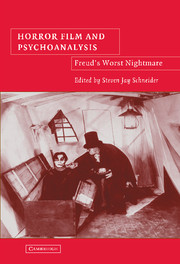Book contents
- Frontmatter
- Contents
- Acknowledgments
- Foreword: “What Lies Beneath?”
- Introduction: “Psychoanalysis in/and/of the Horror Film”
- PART ONE THE QUESTION OF HORROR-PLEASURE
- PART TWO THEORIZING THE UNCANNY
- PART THREE REPRESENTING PSYCHOANALYSIS
- 9 What Does Dr. Judd Want? Transformation, Transference, and Divided Selves in Cat People
- 10 “Ultimate Formlessness”: Cinema, Horror, and the Limits of Meaning
- 11 Freud's Worst Nightmare: Dining with Dr. Hannibal Lecter
- PART FOUR NEW DIRECTIONS
- Afterword: Psychoanalysis and the Horror Film
- About the Contributors
- Bibliography
- Index
10 - “Ultimate Formlessness”: Cinema, Horror, and the Limits of Meaning
Published online by Cambridge University Press: 14 July 2009
- Frontmatter
- Contents
- Acknowledgments
- Foreword: “What Lies Beneath?”
- Introduction: “Psychoanalysis in/and/of the Horror Film”
- PART ONE THE QUESTION OF HORROR-PLEASURE
- PART TWO THEORIZING THE UNCANNY
- PART THREE REPRESENTING PSYCHOANALYSIS
- 9 What Does Dr. Judd Want? Transformation, Transference, and Divided Selves in Cat People
- 10 “Ultimate Formlessness”: Cinema, Horror, and the Limits of Meaning
- 11 Freud's Worst Nightmare: Dining with Dr. Hannibal Lecter
- PART FOUR NEW DIRECTIONS
- Afterword: Psychoanalysis and the Horror Film
- About the Contributors
- Bibliography
- Index
Summary
An approach to some of the questions posed by the relation between popular culture and psychoanalysis is suggested by Barbara Creed's 1986 essay, “Horror and the Monstrous-Feminine: An Imaginary Abjection.” Creed turns to Ridley Scott's 1979 film Alien in an attempt to clarify issues of otherness and the monstrous-feminine. By “monstrous-feminine” she refers to woman seen from the point of view of Freud's understanding of castration – as shocking, terrifying, horrific – as the site of abjection. Her theoretical underpinnings derive from Julia Kristeva's Powers of Horror, a book whose project is to establish the abject as a new theoretical entity beyond meaning – beyond the confines of the human (as understood within patriarchal society) – but which nonetheless can be given significance within a psychoanalytic understanding of the formation of the subject. Creed's aim is to show the inescapable relevance of this to an analysis of dominant culture and the subordination of women within that culture.
Kristeva pictures the abject as a place where meaning collapses, where I, the subject, am not. The abject is thus to be identified with what threatens life, and it must, therefore, be radically excluded from the place of the living subject. The abject, in other words, is all that the subject excludes in order to be what it is, to have the identity that it does. The abject is, for Kristeva, what in Judaism is characterized as “abomination”: sexual perversion, murder, the corpse, incest, and the feminine body.
- Type
- Chapter
- Information
- Horror Film and PsychoanalysisFreud's Worst Nightmare, pp. 177 - 187Publisher: Cambridge University PressPrint publication year: 2004
- 3
- Cited by

